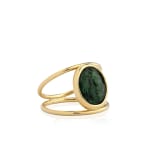


Roman
Dancing maenad green chalcedony gold ring, Roman, circa 2nd century AD
Chalcedony and gold
Ring size UK: I 1/2
Length of intaglio: 1 cm
Length of intaglio: 1 cm
Sold
Further images
The ancient Roman green chalcedony intaglio depicts a dancing maenad. She is facing left, wearing a panther skin, with a thyrsus behind her. Set in a bespoke and handmade modern...
The ancient Roman green chalcedony intaglio depicts a dancing maenad. She is facing left, wearing a panther skin, with a thyrsus behind her. Set in a bespoke and handmade modern 18 carat gold ring.
Provenance
Dr. W.M Collection, Surrey, UK, acquired 1980s-1990s, thence by descentLiterature
Maenads were the female followers and revellers in the cult of the god Dionysus. They were one of the most important parts of his retinue, and they accompanied the god on his travels crowned in wreaths of ivy and draped in animal skins.The name maenad originally meant 'raving ones' as they were believed to be possessed by the god while under his influence. The practice of maenadism is thought to have begun in Thebes, coinciding with the birth place of Dionysus.
The maenads' mode of dress makes them easily identifiable in ancient art. Loose, free flowing hair and dress is combined with other Bacchic attributes such as animal skins, garlands of ivy and a thyrsus. They are almost always depicted barefoot signifying their wildness and unrestraint.


